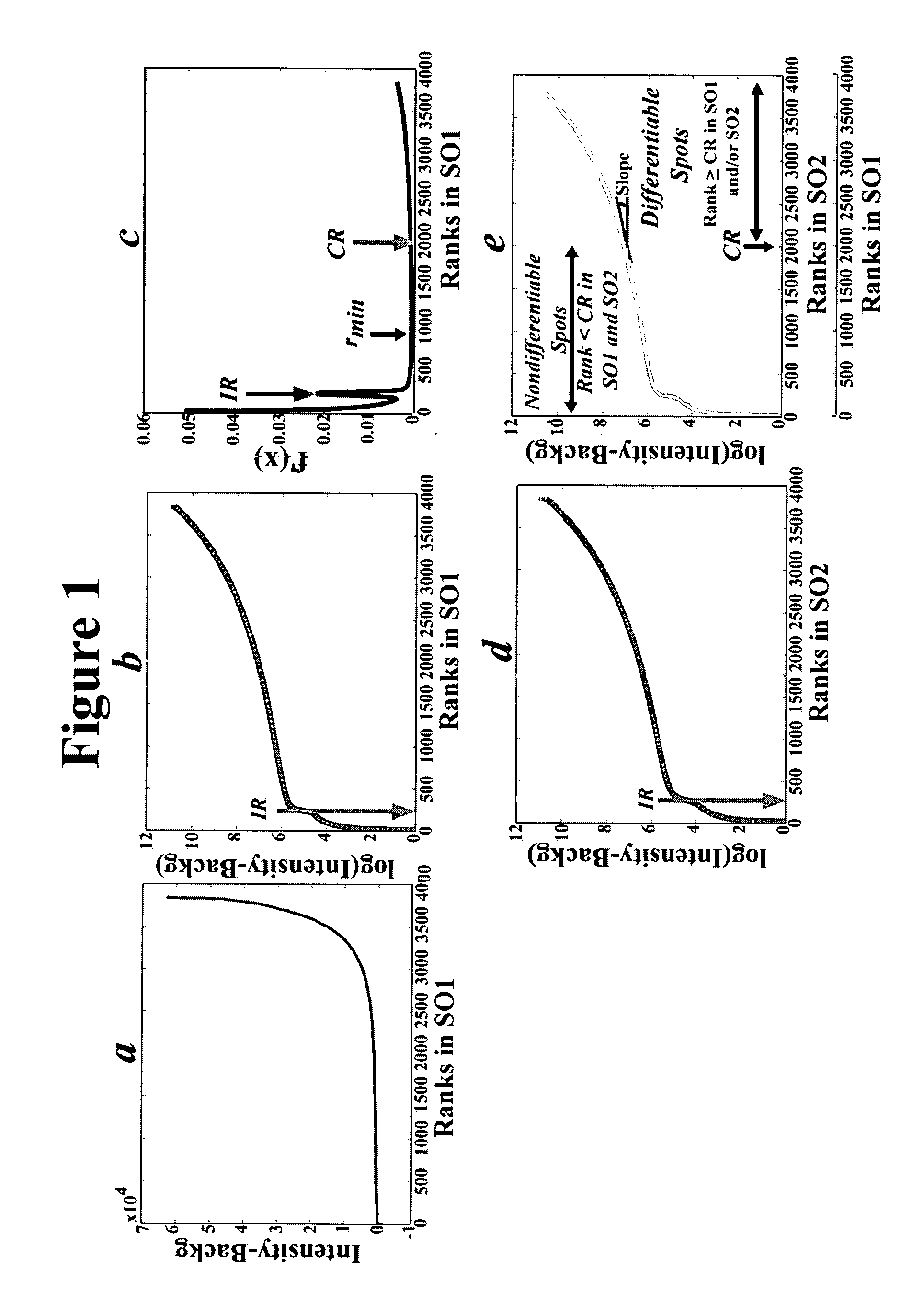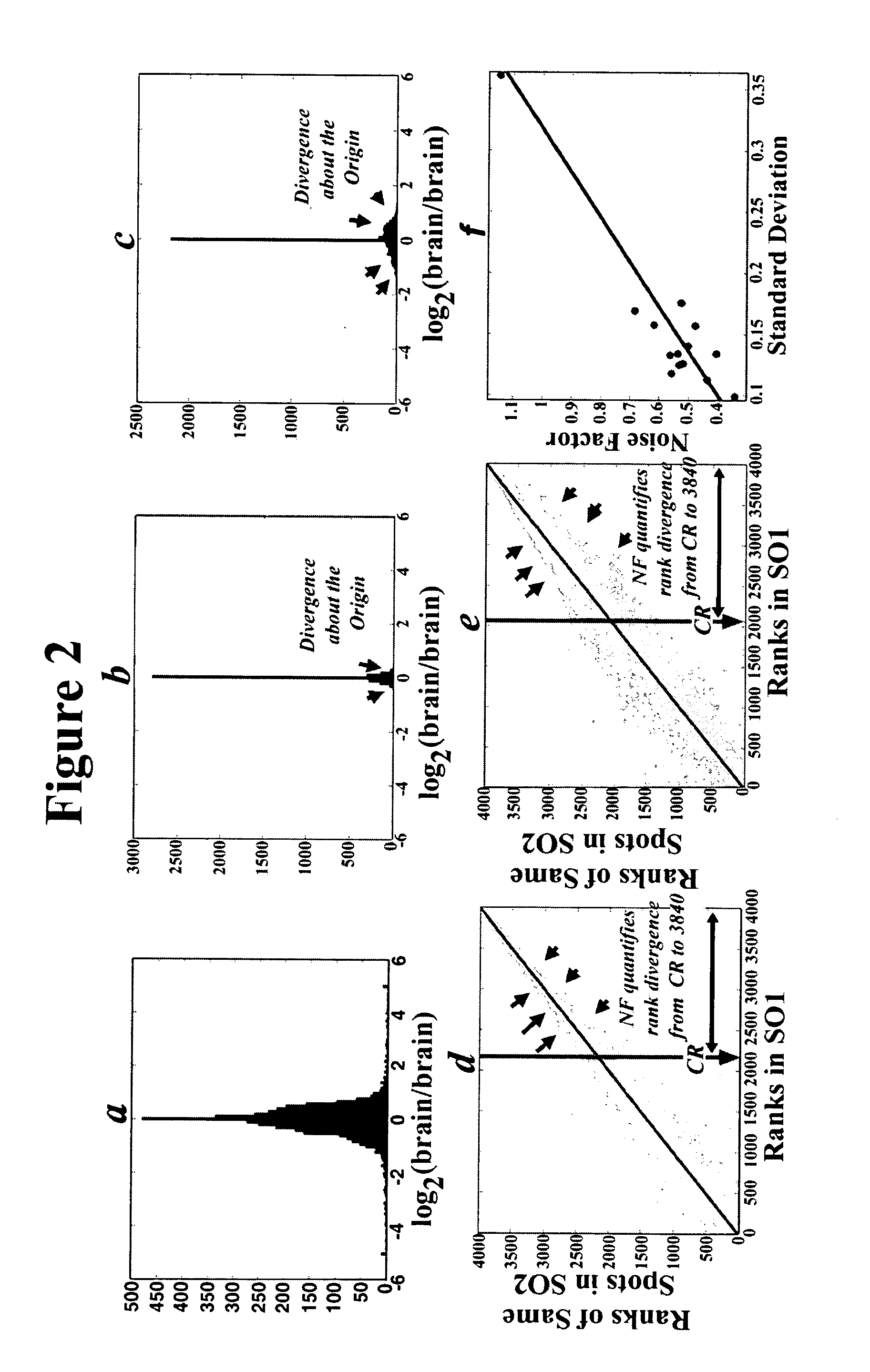Methods for eliminating false data from comparative data matrices and for quantifying data matrix quality
a technology of data matrices and methods, applied in the field of methods for eliminating false data from comparative data matrices and quantifying data matrix quality, can solve the problems of statistical methods suffering, affecting the quality of data, and significantly impairing the assessment of which genes are significantly expressed in a cell, so as to eliminate unreliable data from data sets
- Summary
- Abstract
- Description
- Claims
- Application Information
AI Technical Summary
Benefits of technology
Problems solved by technology
Method used
Image
Examples
example 1
Demonstration of the Algorithm Using Internal Control
[0075] In order to assess the specificity of the algorithm of the present invention, ten probe switching (reverse) experiments comparing normal brain RNA to itself using a 19K microchip and nine experiments using a 1.7K microchip were performed to yield images of heterogeneous quality.
[0076] Methods:
[0077] Samples and Microarrays. Normal brain RNA is obtained by pooling RNA from human occipital lobes harvested and pooled from 4 individuals with no known neurological disease whose brains are frozen less than 3 hours postmortem. The quality of RNA is assayed by gel electrophoresis; only high quality RNA is processed. Total RNA (5-10 μg) is reverse transcribed and the cDNA products labeled by the amino-allyl method and hybridized to the 19K and 1.7K gene microarrays purchased from the Ontario Cancer Institute (Toronto, CA). The slides are scanned at 10 μm by a confocal scanner, (4000XL scanner, Packard Bioscience; Meriden, Conn.)....
example 2
Demonstration of the Algorithm on a Comparative System I
[0082] As a proof of principle, the complete algorithm discussed above is applied to the data of a reverse experiment comparing human meningioma RNA to normal human brain using the 1.7K microarray chip. 21 genes were extracted as sources of real data. The data was validated using real time PCR and by expression profiling of other meningioma samples. The references cited in the results section below are listed at the end of the example.
[0083] Methods:
[0084] Samples and Microarrays. The microarrays were prepared, scanned, and quantified by the methods described in Example 1 above. The meningioma samples were obtained from surgical operations, frozen and stored in liquid nitrogen until the time of use. Total RNA was extracted and transcribed to cDNA which in turn was reacted with the fluorescent probe by the aminoallyl method. Normal brain RNA was pooled from 4 individuals with no known neurological disease whose brains are fro...
example 3
Demonstration of the Algorithm on a Comparative System II
[0094] To explore the idea that genomic expression discovery predicts pathways and functions behind the biological phenotypes of living systems, a tumor was compared to its normal host organ. The expression data accurately predicted activation of signaling pathways and proposed that unbalanced opposing genetic functions create ‘aberrant’ phenotypes. In addition, known molecular interactions revealed a rich network of stimulatory and inhibitory genetic interconnections.
[0095] Microarrays containing 19,200 cDNAs to profile gene expression in 10 meningiomas vs. normal brain were used in the experiment. These studies are described in more detail in J. Biological Chemistry, vol. 278, pages 23830-23833 (2003), which is incorporated herein by reference. Meningiomas were compared to normal brain, its host organ, because both tissue types contain non-tumor cells like blood vessels and cells of lymphocytic lineage. Meningiomas compris...
PUM
| Property | Measurement | Unit |
|---|---|---|
| angle | aaaaa | aaaaa |
| mass | aaaaa | aaaaa |
| nuclei acid sequence expression profiling | aaaaa | aaaaa |
Abstract
Description
Claims
Application Information
 Login to View More
Login to View More - R&D
- Intellectual Property
- Life Sciences
- Materials
- Tech Scout
- Unparalleled Data Quality
- Higher Quality Content
- 60% Fewer Hallucinations
Browse by: Latest US Patents, China's latest patents, Technical Efficacy Thesaurus, Application Domain, Technology Topic, Popular Technical Reports.
© 2025 PatSnap. All rights reserved.Legal|Privacy policy|Modern Slavery Act Transparency Statement|Sitemap|About US| Contact US: help@patsnap.com



